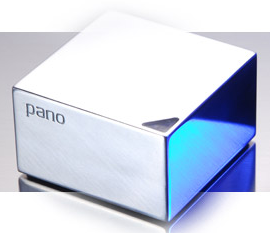Original URL: https://www.theregister.com/2007/08/27/pano_logic_virtualization_pc/
Hit the Pano button - desktops go virtual
A tiny, sliced PC
Posted in Personal Tech, 27th August 2007 06:56 GMT
Marry the renewed thin client/blade PC rage with the uproar around virtualization software, and you get Pano Logic.
The Silicon Valley start-up has crafted a dual-front attack on corporate and consumer PCs. The assault starts with a homemade device called the Pano that handles network, keyboard, mouse, monitor and peripheral connections at the user's desk. Then, the company relies on its Pano Management Server (PMS, unfortunately) to create multiple copies of Windows Vista and XP on a physical server in the data center.
"The network is the bus now," Pano Logic CEO Nick Gault told us, in a meeting at the company's headquarters in Menlo Park. "You can't tell if you're connected over PCI to something a few inches away or over the network to something miles away.
"Any software is a drag at this point. It's a management drag and a security drag."
Gault sounds like he's channeling mid-90s versions of Larry Ellison and Scott McNealy at the height of their thin client lust. In all fairness, though, Gault's enthusiasm for this PC-replacement technology is shared across the industry, despite the historic failings of thin client technology. The likes of Wyse, Citrix, ClearCube, IBM, HP, Sun Microsystems, and Teradici all claim that bandwidth improvements, the painful prospect of Vista upgrades and the costs and security headaches associated with managing desktops mean that thin clients and blade PCs make sense all over again.
Companies have already done the small, desktop device thing, and they've already worked on running multiple PC operating systems on a single physical server. Still, Pano Logic think it's up to something unique.
For one, the company's sleek Pano device has a, er, Pano button.

I Pano
When the first Pano device goes on sale at the end of September, its magic button will deliver only basic tools. Basically, customers can punch the button when their OS or applications stall, and it will tell the server to reboot the virtual machine. In future versions of the device, a push of the button will bring up a number of options around, say, switching between virtual machines configured for certain functions - a plus for the call center worker in your family - or performing and accessing snapshots of data.
Pano Logic is also very proud of its PMS and complementary virtualization technology, which is no surprise since CEO Gault used to run XenSource.
The Pano device has no software whatsoever. So, everything from the application to USB information runs over Ethernet.
"Our software, which sits on the server, knows how to take all this traffic and map it into existing Windows software," Gault said. "All of the device drivers work unmodified, and we can connect into existing Active Directory or LDAP systems to manage users."
For the moment, Pano's software only works in conjunction with VMware's virtualization software and Windows. Down the road, however, you could expect to see Linux and Xen support added.
Get Radical With Us
Realizing that it's asking customers to make a radical shift, Pano has come up with some interesting pricing models. You can, for example, buy the device and software for $20 per month or $180 per year with support. There's a $300 perpetual license available as well with support available at $60 per year. Those prices include VMware's Server software and VirtualCenter 1.4.
There are also different pricing models for mid-sized companies with around 50 devices and virtual desktops and large companies with hundreds of systems that will need VMware's high-end ESX Server. Pano expects large corporate service providers to view its device as a gateway to adding virtual client management as an option to their regular data center management spread.
While initially a corporate play, Pano hopes to attract consumer interest in its device by teaming with service providers that would charge a subscription for a network connection and desktop maintenance.
As with all thin client and blade PC vendors, Pano claims an overall management cost savings by moving to this type of arrangement. Customers often spend a $700 per PC for employees and thousands of dollars dealing with security, maintenance and upgrade issues. By moving the PC to the data center, an administrator can handle most of those tasks centrally.
Pano's pitch seems just as strong to us as the other thin client and blade PC vendors out there. Unlike the Teradici camp, which offers top performance via desk side and server room silicon, Pano gives you a virtual desktop. So, you're saving money and probably getting a good enough experience in most cases. In addition, Pano has a much reduced desktop software burden when compared to most vendors, although we have seen other software-free set-ups.
The company's success will seem to hinge on how well its virtualization software works and how many sophisticated tools Pano can add to match rivals such as VMware and Citrix that own core virtualization technology and have eyes for the PC as well.
You'll find Pano here. ®